The AMD Radeon R9 290 Review
by Ryan Smith on November 5, 2013 12:01 AM EST- Posted in
- GPUs
- AMD
- Radeon
- Hawaii
- Radeon 200
Compute
Jumping into pure compute performance, this is another scenario where the 290X shouldn’t throttle as much, and as such the performance differences between the 290 and 290X should be closer to what they are on paper. With compute workloads the ROPs aren’t being hit hard, so that’s power and thermal savings that lets both cards operate at close to their maximum boost clocks.
As always we'll start with our DirectCompute game example, Civilization V, which uses DirectCompute to decompress textures on the fly. Civ V includes a sub-benchmark that exclusively tests the speed of their texture decompression algorithm by repeatedly decompressing the textures required for one of the game’s leader scenes. While DirectCompute is used in many games, this is one of the only games with a benchmark that can isolate the use of DirectCompute and its resulting performance.
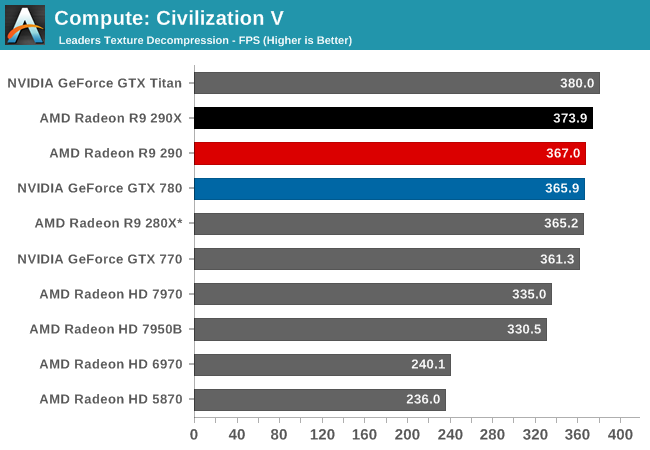
As with the 290X, Civ V can’t tell us much of value due to the fact that we’re running into CPU bottlenecks, not to mention increasingly absurd frame rates. The 290 is marginally slower than the 290X due to the lower clockspeeds and missing CUs, but minimally so.
Our next benchmark is LuxMark2.0, the official benchmark of SmallLuxGPU 2.0. SmallLuxGPU is an OpenCL accelerated ray tracer that is part of the larger LuxRender suite. Ray tracing has become a stronghold for GPUs in recent years as ray tracing maps well to GPU pipelines, allowing artists to render scenes much more quickly than with CPUs alone.
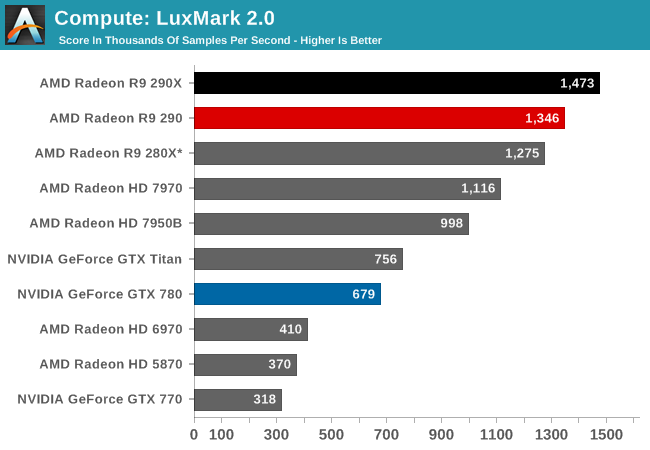
With both cards unthrottled and bound solely by shader performance, it’s an outright foot race for the Radeon cards. 290 trails 290X by around 9%, closely mirroring the difference in the CU count between the two cards. Though 290 is being very closely chased by the 280X, as Hawaii in general seems to have trouble getting the most out of its shader hardware on this benchmark.
Our 3rd compute benchmark is Sony Vegas Pro 12, an OpenGL and OpenCL video editing and authoring package. Vegas can use GPUs in a few different ways, the primary uses being to accelerate the video effects and compositing process itself, and in the video encoding step. With video encoding being increasingly offloaded to dedicated DSPs these days we’re focusing on the editing and compositing process, rendering to a low CPU overhead format (XDCAM EX). This specific test comes from Sony, and measures how long it takes to render a video.
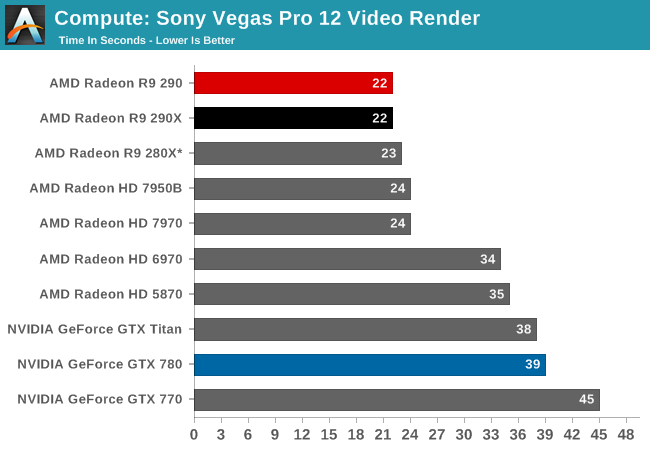
There’s not enough of a GPU performance difference between the two cards to matter with this test. Both tie at 22 seconds.
Our 4th benchmark set comes from CLBenchmark 1.1. CLBenchmark contains a number of subtests; we’re focusing on the most practical of them, the computer vision test and the fluid simulation test. The former being a useful proxy for computer imaging tasks where systems are required to parse images and identify features (e.g. humans), while fluid simulations are common in professional graphics work and games alike.
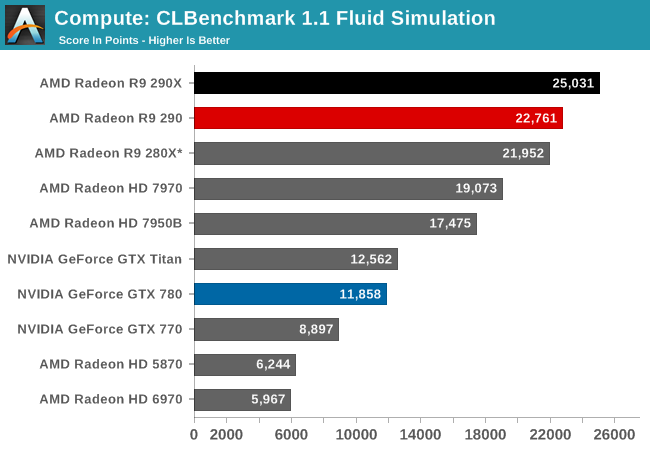

In the CLBenchmark fluid simulation the 290X and 290 take the top spots as expected, with the 290 trailing once more by 9%. However both Hawaii cards are still struggling with the computer vision benchmark, leading to the 290 being edged out by the 7970 of all things.
Moving on, our 5th compute benchmark is FAHBench, the official Folding @ Home benchmark. Folding @ Home is the popular Stanford-backed research and distributed computing initiative that has work distributed to millions of volunteer computers over the internet, each of which is responsible for a tiny slice of a protein folding simulation. FAHBench can test both single precision and double precision floating point performance, with single precision being the most useful metric for most consumer cards due to their low double precision performance. Each precision has two modes, explicit and implicit, the difference being whether water atoms are included in the simulation, which adds quite a bit of work and overhead. This is another OpenCL test, as Folding @ Home has moved exclusively to OpenCL this year with FAHCore 17.
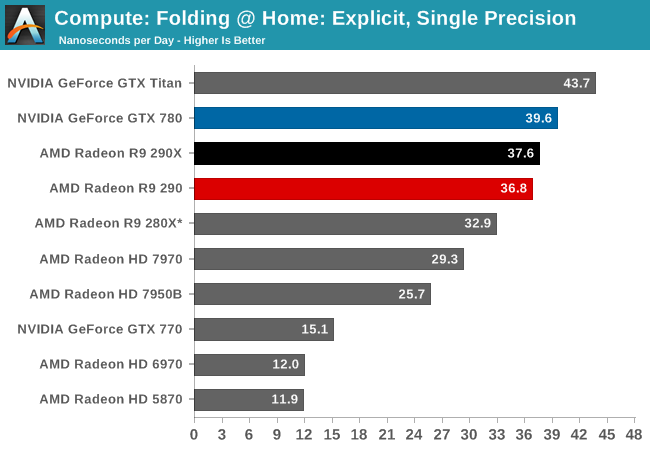
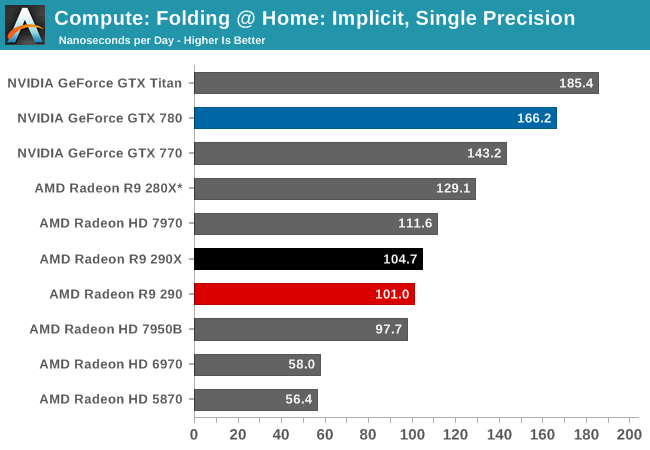
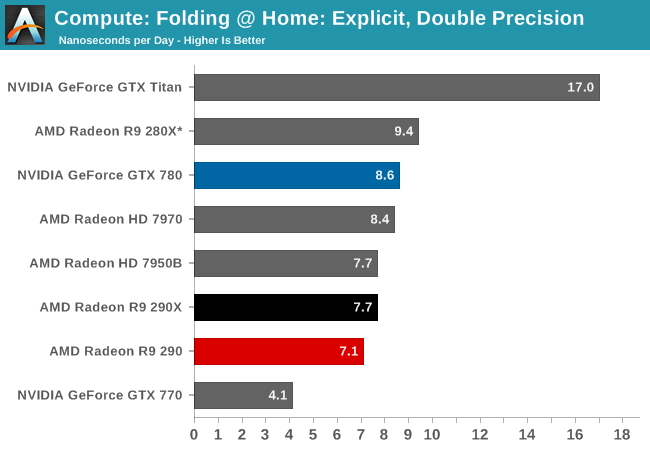
Generally Tahiti and Hawaii are strong performers in the GPU compute arena, but that isn’t of particular help to the 290 here, as it loses out to the GTX 780 in every mode. In single precision FAHBench has trouble putting Hawaii to good use at times, while double precision tests have the 1/8th DP rate 290 and 290X falling behind due to their lower than Tahiti DP throughput.
Wrapping things up, our final compute benchmark is an in-house project developed by our very own Dr. Ian Cutress. SystemCompute is our first C++ AMP benchmark, utilizing Microsoft’s simple C++ extensions to allow the easy use of GPU computing in C++ programs. SystemCompute in turn is a collection of benchmarks for several different fundamental compute algorithms, as described in this previous article, with the final score represented in points. DirectCompute is the compute backend for C++ AMP on Windows, so this forms our other DirectCompute test.
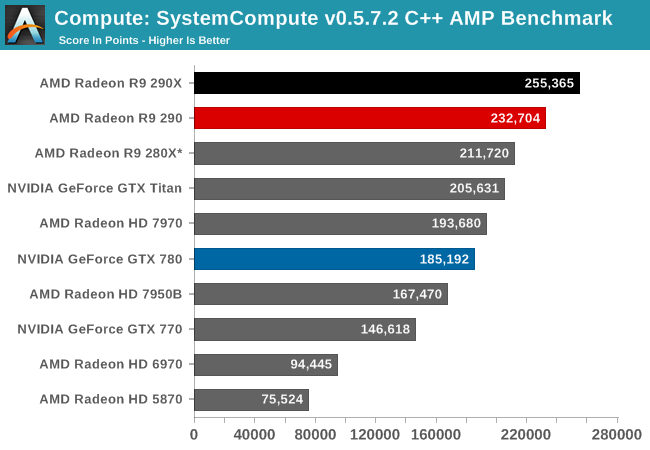
SystemCompute is another benchmark where 290 and 290X do not experience meaningful throttling, and as such are separated by more than what happens in our gaming benchmarks. In this case 290 yet again trails 290X by 9%, though it still enjoys a considerable lead over the GTX 780 and all other NVIDIA cards.










295 Comments
View All Comments
DMCalloway - Wednesday, November 6, 2013 - link
Not sure how to interpret your analogy. Heat is measured in watts (energy) needing dissipation. This card is running up to 95*C while drawing around 50 more watts of power than a 780 . The 780 while drawing 50 less watts of power is running up to 80*C. Out of the gate the heat sink on the R290 is going to have to be at LEAST 20% more effective than the current 780 heat sink, and this thermal excess is still being pumped into the case.Galidou - Friday, November 15, 2013 - link
Well as I can see you are rather unfamiliar with power leakage due to temperature... anyway I won't get into the subject, I'll let you google it. Getting a card to run a lot cooler at the same frequencies can reduces power usage depending on how bad it affects certain node.A 20 degree celsius difference can have a great impact on power usage which I think might turn the tide around. In 28nm design, power leakage has been a bigger problem than before, probably a reason why Nvidia has been using better reference coolers thus, enhancing the performance/watt for the last generations of video cards.
That is the basis of my previous analogy.
TrantaLocked - Tuesday, November 5, 2013 - link
With the card in the case, with headphones on, with sounds/music from the game playing, hearing the 290 or any card would be tough. I know what loud video cards sound like (I owned the 4890 with a single fan design, and I always ran the fan at manual 40%-50% speed for gaming), and when playing a game with headphones the sound is barely audible and definitely not distracting.Calinou__ - Tuesday, November 5, 2013 - link
I have a reference 570 in a sound dampened case and a headset and I can easily hear it, even at idle (40% fan speed)... and I guess the R9 290 is more noisy.Galidou - Tuesday, November 5, 2013 - link
A reference 570 if not cleaned regularly(once every two months) goes easily up to 62 db. GTX 480 went up to 64 db(brand new) and Nvidia fans praised it even if AMD fans were saying it was loud, nothing new in here... Nvidia fans once said that 64 db is ''nothing'' for a good performing card... Look at them now speaking and whining about the same situation, really fun to see the tides turn around...That was in a time when reference coolers where much more used and represented a MUCH bigger % of the market, I would never buy an AMD reference cooled card. Nvidia fans started to care about noise and temperature when they got the 600 series out and for the first time had an advantage.
Finally - Tuesday, November 5, 2013 - link
Whoever buys a card with the default fan? Get one with a custom design and problem solved. How hard is that?Aikouka - Tuesday, November 5, 2013 - link
Anyone that buys it right now? =Pkmmatney - Tuesday, November 5, 2013 - link
I used to think that too, until I actually bought a loud HD4890. I ended up having to get an Accelero, which made it dead quiet. My current NVidia based card is also really loud, but I fixed that buy underclocking it most of the time. Really loud cards are just not fun to deal with. I'd wait for third party cards to come out with better cooling solutions.hoboville - Tuesday, November 5, 2013 - link
Except that it's hot, noisy, and basically pointless to overclock because it's as loud as a medium party without music. So as it is, it's a bad card.However, since it's only $400, one could go out and buy a water cooling setup and have a card faster than the 290x for about the same or less money. For Titan money, you could get a second 290 and add some more rads to your setup. The thing is...if you do want to OC (and why wouldn't you with water cooling?), you'll have to dissipate over 800 watts of heat...
Slomo4shO - Tuesday, November 5, 2013 - link
Well done AMD. Competition at its finest!